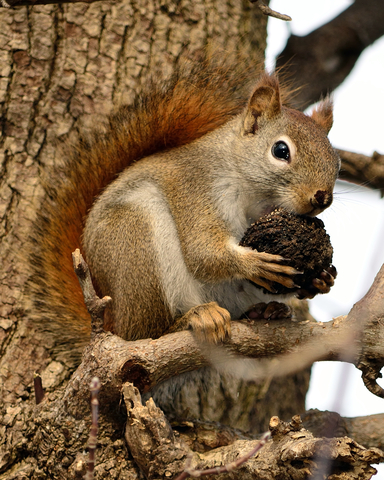 About
About
The scientific name of the red squirrel is Tamiasciurus hudsonicus. The Latin word “Tamias” means “storer” and “sciurus” means “shadow of a tail”. To the Ojibway Indians, the red squirrel is known as “Adjidaumo” meaning “tail-in-the-air”. This species is closely related to the western Douglas squirrel (T.douglasi), which derives its popular name, “chicaree”, from its musical call.
Distribution
The red squirrel is found in Alaska and Quebec and southward, in the Rockies as far south as New Mexico, and in the Appalachians as far south as South Carolina.
Description
About one-half the size of the grey squirrel, the red squirrel weighs about 155.5 to 342.1 g (5 to 11 oz) and measures 25.5 to 38.1 cm (10 to 15 in) from nose to tail. Both male and female have anal glands. The sexes look alike and show seasonal colour variation. In summer, they are rusty red on the upper body and grey-white on the lower, and have a prominent black stripe along each side. The tail is a red colour on top and yellow-grey on the underside. In winter, the fur becomes paler and the black stripes disappear. There are two moults each year.
Life History
The female is usually ready for her first litter by the age of one year, and thereafter can produce two litters annually. Breeding occurs in late February or March and again in June or July. After mating, the males are antagonistic towards each other. The females keep them away from the litters. After a gestation period of 36 to 40 days, from one to seven young are born. They are naked, and remain blind until about 27 days have passed. At about one month, they begin to venture from the nest, and are weaned shortly afterwards. The young disperse in late summer or early fall.
Habitat
The red squirrel’s principal habitat is the coniferous forest, although it can sometimes be found in deciduous forest. Nests are usually built of leaves and perched on branches close to the trunks of trees or within cavities in tree trunks.
Food and Feeding Behaviour
Among the red squirrel’s food sources are seeds of pine and spruce, nuts, mushrooms, meat, sap, young birds and birds’ eggs, and a variety of berries. Food is cached, sometimes in quantities amounting to more than a bushel. Favourite feeding spots are habitually maintained.
Habits
Active by day and on moonlit nights, the red squirrel is a chatterer. It clucks, grunts, and calls out warnings, which help it maintain its territory. Except during the breeding season, it is a solitary creature that is very likely to fight interlopers. Its home range is usually less than 182 m (200 yd) in diameter. The red squirrel is agile in the trees, and can jump outward 1.5 m (5 ft) and upward .9 m (3 ft) from a moving branch. It is also a good swimmer.
Population Changes
The population density varies according to the habitat and the season. There may be only one squirrel in an area of 8 ha (about 20 ac), or as many as 25 in 1 ha (2.5 ac).

You must be logged in to post a comment.